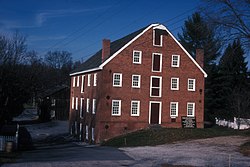Union Mills Homestead Historic District
Union Mills Homestead Historic District | |
 in 1971 | |
| Location | Jct. of U.S. 140 and Deep Run Rd., Westminster, Maryland |
|---|---|
| Coordinates | 39°40′14″N 77°0′58″W / 39.67056°N 77.01611°W |
| Area | 279 acres (113 ha) |
| Built by | Shriver, Andrew; Schriver, David |
| NRHP reference No. | 71000371[1] |
| Added to NRHP | January 25, 1971 |
Union Mills Homestead Historic District is a national
.Description
The homestead comprises a dwelling house, a brick
History
The
Union Mills was added to the National Register of Historic Places in 1971.[1]
The Union Mills Homestead was home to the Shriver family for 6 generations. It is currently a historic landmark located near Westminster, Maryland, about 17 miles south of Gettysburg, Pennsylvania. The Homestead is now a museum of American culture, operated by the Union Mills Homestead Foundation, a non-profit foundation with all proceeds dedicated to the preservation and restoration of the Union Mills Homestead Complex.
The building of the Shriver homestead
The following passage is excerpted from "Union Mills: The Shriver Homestead Since 1797" by Frederic Shriver Klein:
The Shriver brothers bought a large tract of land along Big Pipe Creek, about seven miles north of
saw mill. On March 13, Jacob Keefer and John Eckert contracted "to mould and burn a kiln of brick" for the mill, "providing 100,000 brick or more, to be paid for at the rate of one French crown for every thousand brick." The brick kiln was constructed near the creek, known in previous years as Pipeclay Creek., for building a small double house as a residence for the two brothers. Kohlstock, a joiner, agreed "to finish two small houses 14 by 17 feet each, to be connected by a porch and passage about 10 feet wide." Each house had one upper and one lower room, with a connecting center hallway and a small porch in front, twelve by eight feet. The carpenter's bill for labor gives an interesting idea of costs in 1797:
The house had its origin on January 26 of the same year, when a contract was made with Henry Kohlstock of York County, Pennsylvania
- Lower floors for small house 5 dols.
- Upper floor, rough 3 dols.
- Windows, casing, frames and sash 2 dols. each
- Doors, casings, etc. 2 dols.each
- Weatherboarding, stairs, porch, cornice seats, washboards 3 dols.
- Painting 6 dols.
The total labor costs for the house came to eighty-six dollars!" [3]
References
- ^ a b "National Register Information System". National Register of Historic Places. National Park Service. July 9, 2010.
- ^ Mrs. Preston Parish (November 1970). "National Register of Historic Places Registration: Union Mills Homestead Historic District" (PDF). Maryland Historical Trust. Retrieved January 1, 2016.
- ^ Frederic Shriver Klein (December 1957). "Union Mills: The Shriver Homestead Since 1797". The Maryland Historical Magazine. Union Mills Homestead Foundation.
External links
- Union Mills Homestead Historic District, Carroll County, including photo from 2002, at Maryland Historical Trust
- Boundary Map of the Union Mills Homestead Historic District, Carroll County, at Maryland Historical Trust
- Union Mills Homestead
- Historic American Engineering Record (HAER) No. md-170, "Bollman Truss Bridge, Union Mills Homestead Park, 3311 Littlestown Pike, Westminster, Carroll County, MD", 1 photo, 1 photo caption page




